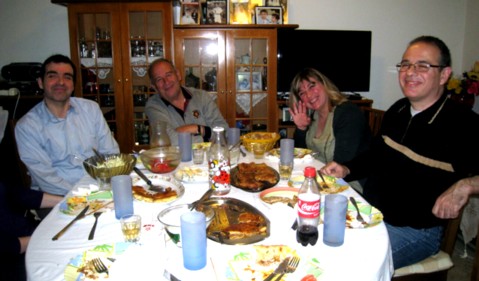 |
|
|
What Was the Hospitality at 2015 Easter in Athens and the Peloponnese? |
|
Seize the moment. Spring brings experiences that we wait for all winter. Begin a new chapter by enjoying the cuisine of Greece. The traveler learns the culture, geography, history and traditions through journeys, not through books or the Internet. Cuisine is a place to begin. Despina Siolas, M.D., Ph.D. and her husband, Laurentino Ibarra, seized their moment. They travelled: Athens in one day and the Peloponnese in seven days during the Easter season 2015. How did they celebrate Easter 2015 with middle-class Greeks? By sharing in celebrations honoring the values of tradition, family, Greek Orthodoxy and patriotism. The couple began a seven day travel from Nafplio, Mycenae, Areopoli, Pylos, Dimitsana and Tripoli in the heartland of “Old Greece” where the Greek Revolution began. |
|
|
“I wanted to celebrate Easter with my father’s family,” she said. “Persons have a positive outlook. They welcome tourism. Hospitality to strangers is unique in Greece. Everyone knows English, even in the smallest village. Laurentino, who does not know Greek, was able to communicate with all in English. Their visit has cemented Hellenism for the next generation of our family.”
They were greeted at the Athens airport in April by her father’s adopted sister, Pitsa Tsakonas, a retired senior librarian of the Benaki Museum. Tsakonas’family were refugees from Smyrna; her husband is from the Peloponnese. She greeted them fluently in English, transporting them to their Athens hotel. After a day spent at the Acropolis and its museum, the group enjoyed an evening dinner of homemade Greek cuisine with the Tsakonas family at their Kessarini home. |
|
Pitsa Tsakonas prepared tiropites (small cheese pies), horiatiki salad (traditional Greek salad), patates (fried potatoes), kima me macaronia (pasta with meat sauce), souvlaki (small pieces of skewered and grilled meat) and other Greek dishes. They met Pitsa’s daughter, a librarian at the Benaki Museum, her retired husband and two adorable grandchildren under the age of five. Hospitality, graciousness and a genuine interest in the American tourists’ welfare shaped the evening’s atmosphere. Cheerfulness and laughter predominated. “Cabbage dishes are very popular at this time served as a lahanosalada (salad of greens). The traditional horiatiki salad with feta cheese, souvlaki, tzatziki (cucumber yogurt dip), mousaka (eggplant, meat, and pasta casserole) was served. Pitsa made her own tiropites from scratch. Every family has their own house wine that is homemade; Pitsa’s wine was produced by a relative from the Peloponnese. Pitchers of water and beer were also served. Dessert was chocolate covered ice cream sandwiches with ice cream cones. “Enjoying food with the Tsakonas family brought us closer together,” Dr. Tsiolas said. “Sharing food with Greek families is part of the Greek travel experience. We came together as a family, communicating through Greek cuisine a positive interaction.” The evening ended by visiting “Porto Kagio” that serves traditional cuisine of Mani, Peloponnese. Christos, the owner, greeted everyone warmly with musicians Panteli and others. A wall painting of Mani and traditional Greek folk arts adorned the interior. For additional information about Porto Kagio in the southern Peloponnese and its restaurants, see the Internet URL http://www.tripadvisor.com/Restaurant_Review-g1191893-d6839306-Reviews-Porto_Kagio-Agia_Paraskevi_Athens_Attica.html. A view of the life of a middle class Athenian family thus ended. The couple’s new adventure was sightseeing at Mycenae and Nafplio. Sunset in Mycenae was magical. The greenery, sunflowers and trees project a different image of Mycenaean civilization. The travelers arrived at Nafplio, staying at Dafni Pension from April 4th and 5th. The comfortable rooms cost 112 euros for two nights (http://pensiondafni.gr/en/). Their unique experience of Easter and Holy Week in the Peloponnese was just beginning. Sightseeing included Palamidi Castle and its 999 steps, Peloponnesian Folklore Foundation “V. Papantoniou,” a miniature windmill, St. Spyridon Church, the first pharmacy of Greece, a run along Karathona Beach, and walking paths and sights about town. Two dogs were tied opposite a Nafplio restaurant barking at its owner, an unforgettable human interest sight. Store-bought Easter lampades (large candles) were decorated with toys and flowers for all. |
|
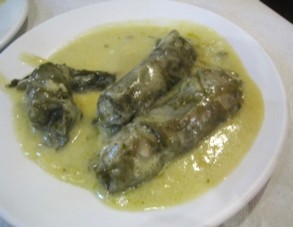 Dolmathes with meat and rice, Taverna Beto, Nafplio |
Being at the Taverna Beto was the highlight of their Nafplio culinary experience. “The best psarosoupa (fish soup) I ever tasted,” said Dr. Tsiolas. “We kept coming back to enjoy the cuisine. This had a lot to do with the warm hospitality of the owners. We were constantly being treated to wine, bear tsipouro (a local fish) and cheese, their graciousness showed the best of Greece’s legendary hospitality. Young musicians in a band played music with everyone dancing. The restaurant was open for a year. (http://www.tripadvisor.com/ Restaurant_Review-g319780-d4867348-Reviews-Taverna_Beto-Nafplio_Argolis_Region_Peloponnese.html).We enjoyed gigantes (giant beans), dolmathes with meat and rice (stuffed grape leaves), fried potatoes, okra with potatoes, carrots, souvlaki, tzatziki, grilled peppers, potatoes with lemon and octopus during our stay [as well as] meliasti, a filo-wrapped cheese with honey and sesame.” |
“We learned some interesting facts on grilled shrimp,” explained the tourist. “The head must be kept on to keep the juice. In Greece, they keep the shrimp head on. In the U.S., shrimp is grilled and cooked without a head. Keeping the head on the shrimp keeps it juicy. Many were sucking on the shrimp head to get the juice. Seafood was very popular during Easter week. We had squid stuffed with feta, parsley, olive oil, lemon juice with salad. The Folklore Museum showed an aristocratic table with crystals, hand-cut tablecloths. It looked straight out of a bridal registry from Macy’s and Bed, Bath and Beyond. A box of traditional koulourakia (Greek butter twist cookies), vanilla, cinnamon, pistachio and chocolate biscotti and nistisima (Lenten) cookies was a souvenir of Nafplio. |
|
| “Laurentino, unknowingly, wore a green shirt that appeared [to suggest that] he supported Panathinaikos,” she said. “They kept treating him to wine, beer, tsipouro and cheese. Panathinaikos was popular at this taverna.” Panathinaikos Athlitikos Omilos is a professional Greek soccer team founded in 1908. It is a successful team in the Soccer Super League of Greece. (http://en.wikipedia.org/wiki/Panathinaikos_F.C.). [Taverna Beto demonstrated] Greek hospitality at its best. |
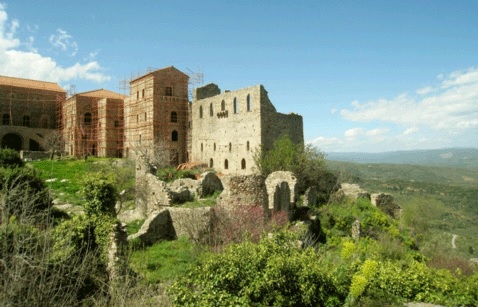 Mystra in the spring |
With their rented car, the tourists drove to Areopoli, passing Sparta and Mystra, on Holy Monday. April 6th. The National Highway was empty. A gigantic statue of Leonidas greeted them in Sparta. “Both ancient and modern writers have used the Battle of Thermopylae as an example of the power of a patriotic army defending its native soil,” according to Wikipedia contributors at http://en.wikipedia.org/wiki/Battle_of_Thermopylae. “The performance of the defenders at the Battle of Thermopylae is also used as an example of the advantages of training, equipment, and good use of terrain as force multipliers and has become a symbol of courage against overwhelming odds.” At the Xenia Mystra Café, they enjoyed a spring view of the Laconian countryside with blooming olive trees. Keftedes (Greek-style meatballs) with cloves, cinnamon and olive oil was one of the aromatic dishes. The old-world atmosphere of these restaurants with white tablecloths including the panoramic view gives one a feeling of contentment. Mystra came alive with the look of spring framed by Mount Taygetos looming in the background. A lizard was seen in the spring flowers. “Families lived there up to the 1950’s,” said Dr. Tsiolas. “The Despot (ruler) lived at the highest point. The poorer classes lived outside the tower. Palm Sunday, April 6th was a perfect time for sightseeing: not too hot or cold; no lines of tourists.” Visiting the Museum of the Olive and Greek Olive Oil at 129 Othonas-Amalia (www.piop.gr) showed the production and history of olive. It is part of a group of industrial museums set up by the Piraeus Bank Group Cultural Foundation. The Water Mill Museum in Dimitsana is part of the Foundation. |
|
Driving to Mani showed them the rugged Peloponnesian mountainous landscape. Instead of staying at a hotel, the couple chose to lodge at the traditional Xenonas Elixirion Guesthouses in Karavostasi of Mani ‘We picked it because Karavostasi is on the water, the Messinian Gulf” explained the tourist. “It was an old pirates' hide-out.” The architecture, traditional Greek rooms, ceramic bathrooms can be seen at http://www.mani-elixirion.com. A welcome tray of sweets greeted them in their room with a water view; waves crashing on the shore reminded them of traveling on a cruise. They ate at a town nearby, Ifilos, at Mavro Pirates (Black Pirates). |
|
| The Elixirion owners in their welcome explained “visitors of the area as well as guests of our guesthouse will have the opportunity to taste and enjoy exquisite plates upon request from Mrs. Maria Sotirakis. Our guests will be able to see for themselves the truth in our sayings by visiting our biological farm and olive trees where we produce our own olive oil. All our recipes are biological coming from our farm. The meat is from local Mani producers.” [Edd: In the U.S. we use the term "organic" instead of "biological" to denote farming without chemicals and pesticides, but the use of "biological" here reflects the actual translation of the hotels owners in accordance with the custom in Greece.] The tourists were impressed with Easter decorations of flowers, eggs, chicks, chocolate-covered bread, and homemade jellies. Breakfast included Easter baskets with eggs, chicks, lady bugs and butterflies. A burning fireplace gave a hospitable feeling while they watched the Messinian gulf from the windows. Later, the couple visited the unique Caves of Dirou. (For more info see http://www.tripadvisor.com/Attraction_Review-g189483-d198894-Reviews-Caves_of_Dirou-Peloponnese.html). |
 Easter baskets at Xenonas Elixirion, Mani |
“Mani is famous for its tower-houses without stairways,” she explained. “They were built because of the feuds among families for defense. A ladder thrown from the top was needed to get into the tower. They reminded me of the princess in the fairy tale ‘Rapunzel.’” |
|
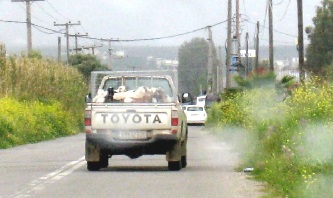 Pylos, a pickup truck with goats and lambs on way to Asfalion, 2015 Easter week |
On Tuesday, April 7th they drove through the olive groves of Kalamata to reached Pylos, the site of the Battle of Navarino in the Greek War of Independence. The couple stayed at Tina’s House for 60 euros a night (http://www.pylosrooms.com). “Tina’s House on the water is unexplainable. They had a fireplace with a miniature, running water mill running in the dining room.” According to the owners, “Its stunning location on the highest spot in town offers to every traveler moments of calmness and relaxation, since combining an insuperable view to the sea with the boundless serenity of nature. Our recently refurbished rooms, affording a special decoration, refer to the old mansions of Pylos. Enjoy the unique experience of sunset from your balcony or even while savoring local flavors on Tina's House yard.” Visiting the Peloponnesian coast appears to be like visiting an island.
|
| “As we were leaving Pylos, a pickup truck with goats and lambs stopped us,” said Despina. “The driver asked us in Greek for directions to the Asfalion (Insurance building). We said we were not locals but from New York. He left us, searching for the Asfalion.” What do you think was the destination of lamb and goats during Easter week? On April 8th and 9th, Holy Wednesday and Holy Thursday, Tsiolas and Ibarra traveled to Dimitsana, (ancient Teuthis), arriving at Xenonas Enastron for 71 euros a night (http://www.tripadvisor.com/Hotel_Review-g970271-d1440372-Reviews-Enastron-Dimitsana_Arkadia_Region_Peloponnese.html) “Enastron was better than the Sofitel by Athens Airport. The view of the mountain, books, DVD’s, videos, slippers, towels, loukoumia (traditional sweets) and free matia (traditional apotropaic talismans) in our rooms gave us a feeling of real hospitality. When I was in Dimitsana, the bed and breakfast owners made bougatsa (sweet custard) for breakfast and gave me some to take with me during the day. The breakfast had koulourakia, kreopita (meat pies), homemade jellies of apricot, caramel, plum, citrus, and peach, and pomegranate with Nutella and honey from Mani. Her jellies are popular and she sells them. Fresh oranges were pressed into orange juice every morning with lahanopita (pies filled with greens), yogurt and cereal. The owner said he had been drinking chamomile for thirty-five years. The owners even gave us kreopites, pites (small filled pies) and sandwiches to take with us to the Lousios Gorge (http://en.wikipedia.org/wiki/Lousios). Goats were running along mountain roads.” |
|
“The fireplace and heated floors gave us comfort. The dining area had baskets of red flowers with Easter eggs on embroidered tablecloths. We passed a petting farm and saw a friendly pony near the road. The pony showed real affection for company. A beautiful sight for the traveler!” The Open Air Water Power Museum, a major attraction, mentioned an interesting fact about Dimitsana. “Dimitsana isolated among the mountains possessed not only the know-how of collecting saltpeter and manufacturing black powder, but also combustibles, plenty of water power and a knowledge to use it.‘ We had powder,’ wrote Theodoros Kolokotronis,‘ because we had Dimitsana.’” (http://www.travelsingreece.com/ sightseeing/dimitsana-open-air-water-power-museum). The Museum showed the old-fashioned way of making tsipouro. |
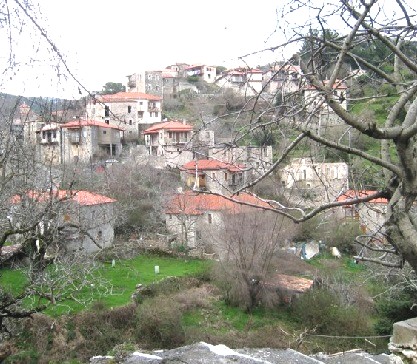 Dimitsana |
| On the road to Olympia, they stopped at Stemnitsa, famous for its jewelry college and as a weekend getaway for persons from Athens. A local restaurant served luncheons of octopus with macaroni, fish, beef and potatoes. The ruins of Olympia had spring flowers and flowering trees signalling rebirth. Shells in rocks, a sleeping, unhappy dog, Hermes Praxiteles, the Olympia Museum, and Olympic Stadium were some of their impressions (http://en.wikipedia.org/wiki/Olympia,_Greece). Then they drove to Tripoli on Good Friday and stayed at the Hotel Mainalon facing Plateos Areos, the main square. Their Lenten dinner was octopus, shrimp pasta, French fries and bread—, all organic and without chemicals. Pastry shops had windows filled with tsoureki (traditional braided Greek Easter sweet breads) covered with white chocolate, thumbprint cookies with jelly, baklava (traditional honeyed filo and walnut pastry) and kourabiedes (Greek traditional powdered shortbread cookie). |
|
Dr. Despina Siolas and her husband, Laurentino Ibarra, witnessed the unique Holy Friday Greek Orthodox celebration in Tripoli with their relatives Pitsa Gerou Macarouni, a philologist, her husband Christo Macarouni and three sons and her God-brother, Dr. Alexios Vardouniotis, ENT surgeon and his wife Kanela, a psychologist, and son Spyridon (Clint). [Edd: A "God-brother" is the son of one's Godparent. In Greek culture the strong and close ties created by baptising a child often extend to the entire family.] “Holy Friday was special because we spent the evening with middle-class families holding onto the old traditions,” explained Dr. Tsiolas. Areos Square was decorated with butterflies and a giant red Easter egg. The Holy Friday Lamentations featured the Procession of the Epitafia (carved wooden representation of the bier of Christ) of eight different church communities from the area paraded around Agiou Vasiliou Square. Chanter, Orpheus, and City of Tripoli choruses, the military, and citizens participated in the Epitafio processions that led to the cemetery outside of town. |
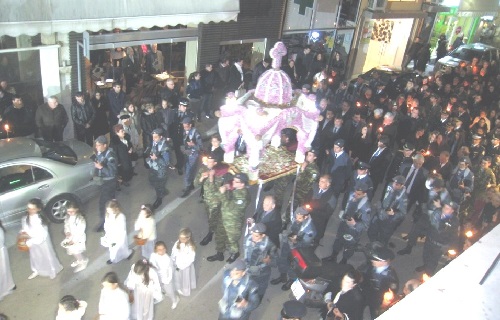 Holy Friday, Tripolis, Greece |
Holy Saturday was spent hiking through the Lousios Gorge, which has been inhabited for centuries by monks and hermits in caves. Two monasteries remain open to visitors, Philosophou and Prodromo (http://en.wikipedia.org/wiki/Lousios). Philosophou is famous due to its reputation as being a secret school during the Ottoman occupation. On their return to the hotel, they received two Easter candles on behalf of Tripoli city by its mayor, Dimitis Pavlis. “From the bottom of my heart, we wish every person a Kalo Pasha,” his message read. “May the Holy Light illuminate the lives of young and old with Love, Hope, Health and Progress. Happy Resurrection.” In addition, they had a platter of koulourakia, a tsoureki and two eggs. “We said ‘Christos Anesti’ with my aunt, philologist Pitsa Gerou Macarouni, and her husband Christo and three sons,” explained Dr. Tsiolas. “ They all hold onto old traditions. Aunt Pitsa told me ‘I have a fourth child, a daughter, you, Despina. You are my blood.’” Blood ties are very important in 2015 Greece. Their home had photos of family members in traditional tsolia (male military attire), amalia costumes (women’s traditional attire) and military uniforms. “Holy Saturday evening in Tripoli is different from New York,” she explained. “We attended church at Agio Vasilis church with a presentation of the military, chanting of Christos Anesti, firecrackers and fireworks. Everyone was happy. We took the Holy Light to Thia Pitsa and Thio Christo’s home. Everyone burnt the entrance to the door frame with their candle for good luck.” Would we do this in the U.S.A.? Most people in America would likely be frightened of a fire. The Greeks are brave. |
|
Easter morning dinner at 1 a.m. was cracking red eggs for good luck with magiritsa (traditional Easter egg lemon soup with liver or other meat chunks), tomatoes, feta, kasseri (a type of hard cheese), tiropita, salad, Italian bread, barbecued lamb cut up in pieces, and wine. The house was decorated with colorful embroidered tablecloths, tulips, rabbits, chocolate-covered tsoureki, red roosters, chocolate Easter cookies, chocolate eggs and chocolate and a large red Easter egg. “We want you, Despina, and Laurentino to communicate with our children as long as you live,” said philologist Pitsa Gerou Macarouni. “We want blood ties to continue among our youth. This is the meaning of family.” Laurentino received a present of worry beads so he could use them and remember Tripoli. On Easter Sunday, the city of Tripoli has an exciting Easter celebration at Areos Square with lambs barbecuing, tsoureki, Easter eggs, koulourakia, and wine, all with traditional folk-dancing. This is free to the public. The City of Tripoli understands their community comes together in preparing food for their Easter celebration. Bonding takes place. The visiting couple enjoyed being with Dr. Alex and family, Thia Pitsa, Thio Christo and family. They then returned to Athens. |
 Tsakonas Family with Dr. Despina and husband Laurentino (5th and 6th from left to right) at Easter night services |
|
|
|
|
(Posting date 12 May 2015) Note: Formatting and editing of this article for Internet by HCS staff. HCS encourages readers to view other fine articles ( http://www.helleniccomserve.com/archivetsounis.html ) penned by Dr. Catherine Tsounis and press releases about the Modern Greek Studies program at St. John's University, where she is an adjunct professor. For more information about Dr. Tsounis, see her biographical sketch at http://www.helleniccomserve.com/biotsouniscatherine.html HCS encourages readers to view other articles and releases in our permanent, extensive archives at the URL http://www.helleniccomserve.com/contents.html. |
|
|
|
|
2000 © Hellenic Communication Service, L.L.C. All Rights Reserved.
http://www.HellenicComServe.com |
|
